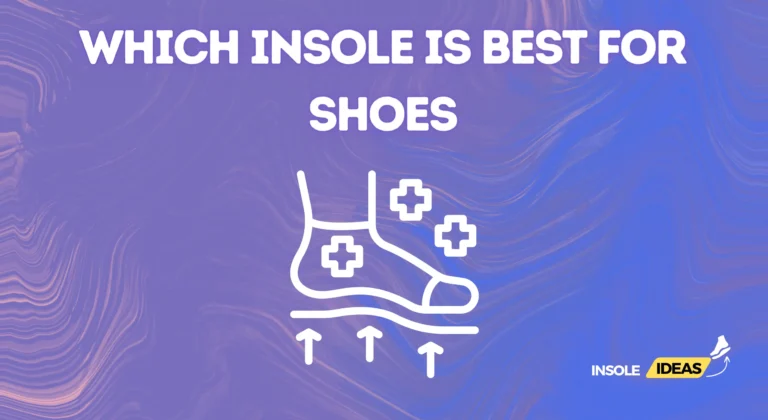Unveiling the Ultimate Guide: “Insole When to Wear?”
Introduction
Although they are sometimes disregarded, insoles are essential for preserving the general health and wellbeing of the feet. These small inserts are designed to provide additional support, cushioning, and stability to your feet. This introduction aims to shed light on the significance of insoles, exploring their brief overview, the importance of wearing them, and addressing common misconceptions.
Brief Overview of Insoles
Although they are sometimes disregarded, insoles are essential for preserving the general health and wellbeing of the feet. They come in various materials and designs, catering to different foot types and specific needs. Whether you’re an athlete seeking performance improvement or someone with foot conditions, insoles can make a substantial difference in your daily life.
Importance of Wearing Insoles
Understanding the importance of insoles involves recognizing their role in mitigating foot pain, improving posture, and preventing injuries. From absorbing shock to distributing pressure evenly, insoles contribute to overall foot health. This section delves into the multifaceted benefits of wearing insoles and how they can positively impact your daily activities.
C. Addressing Common Misconceptions
Despite their advantages: insoles sometimes face misconceptions that hinder people from incorporating them into their footwear routine. Common myths such as “insoles are only for people with foot problems” or “they are uncomfortable” need to be dispelled. By addressing these misconceptions, individuals can make informed decisions about integrating insoles into their daily lives.
II. Understanding Foot Mechanics
To comprehend when to wear insoles, it’s essential to delve into the intricacies of foot mechanics. This section breaks down the anatomy of the foot, explores different foot arch types, and analyzes how foot mechanics impact various daily activities.
A. Anatomy of the Foot
With its 33 joints, 26 bones, and an abundance of muscles, tendons, and ligaments, the human foot is a complicated anatomical system. Understanding this intricate anatomy provides insight into how the foot functions and why additional support, such as insoles, can be beneficial.
B. Foot Arch Types
Individuals have different foot arch types—flat, neutral, or high arches. Each arch type requires specific support to maintain proper alignment and prevent issues like overpronation or supination. This section elucidates the characteristics of each arch type and recommends suitable insole options.
C. Impact of Foot Mechanics on Daily Activities
Walking, running, and prolonged standing all have a big impact on daily activities due to foot mechanics. Improper alignment or lack of support can lead to discomfort and pain. By understanding how foot mechanics impact different activities, individuals can determine when to wear insoles for optimal comfort and performance.
Top of Form
Signs Indicating the Need for Insoles
Foot health is paramount, and recognizing signs that indicate the need for insoles is crucial. Addressing these signals promptly can prevent discomfort and potential issues down the line.
Foot Pain and Discomfort
One of the most apparent signs prompting the use of insoles is
persistent foot pain and discomfort. Whether experienced in the arches, heels,
or balls of the feet, such pain may indicate inadequate support or alignment
issues. In this section, we explore the various types of foot pain and how
insoles can alleviate discomfort.
Alignment Issues
An array of issues affecting not only the feet but also the knees, hips, and lower back can result from misalignment of the feet. Signs of alignment issues include overpronation or supination. Understanding how insoles can correct alignment problems is essential for maintaining optimal foot mechanics and overall body alignment.
Impact on Posture
Posture is closely linked to foot health. Feet serve as the foundation for the body, and any issues with them can affect posture. Insoles play a vital role in supporting the natural alignment of the feet, thus contributing to improved posture. This section looks at how using insoles can improve posture and lower the chance of developing musculoskeletal problems.
Sporting Activities
Engaging in sports places unique demands on the feet. Athletes often experience specific foot-related challenges, such as excessive impact and pronation during activities. Insoles designed for sporting activities can provide the necessary support and shock absorption. This part delves into the importance of insoles in various sports and activities.
Types of Insoles
Not all insoles are created equal, and understanding the different types available is essential for choosing the right ones based on individual needs and preferences.
Cushioned Insoles
The purpose of cushioned insoles is to offer more cushioning and absorb shock. Those who participate in high-impact activities or spend a lot of time on their feet would benefit most from them. This section details the features of cushioned insoles and when they are most appropriate.
Arch Support Insoles
Arch support insoles cater to individuals with specific arch types, addressing issues related to flat feet, high arches, or neutral arches. This subsection explores the importance of arch support and how these insoles can contribute to proper foot alignment.
Custom Orthotics
For those with unique foot structures or specific conditions, custom orthotics offer personalized support. This part discusses the process of obtaining custom orthotics and the scenarios in which they are recommended.
Gel Insoles
Gel insoles are renowned for offering superior support and cushioning. This section outlines the benefits of gel insoles, their applications, and the types of footwear they complement.
Matching Insoles to Footwear
Choosing the right insoles involves considering the type of footwear they’ll be paired with. Different shoes serve distinct purposes, and selecting insoles tailored to the specific demands of each type ensures optimal comfort and support.
Everyday Shoes
In everyday footwear like sneakers, loafers, or casual shoes, the emphasis is on comfort for prolonged wear. In this section, we explore the importance of insoles in everyday shoes, addressing how they enhance cushioning and support for activities like walking and standing.
Athletic Footwear
Athletic shoes are made for particular sports and activities, each of which has different needs for support. Matching the right insoles to athletic footwear can enhance performance, reduce fatigue, and prevent injuries. This subsection delves into the compatibility of different insole types with various sports and athletic pursuits.
High Heels and Dress Shoes
High heels and dress shoes often lack sufficient arch support and cushioning, contributing to foot discomfort. In this part, we discuss how insoles designed for dressier footwear can alleviate pressure, provide arch support, and make these shoes more comfortable for extended wear.
Work Boots and Safety Footwear
Work boots and safety footwear are essential for protection in various occupations. However, they may not always offer the desired comfort. This section explores the significance of pairing the right insoles with work boots, addressing the specific needs of individuals in physically demanding jobs.
When to Wear Insoles
Understanding the appropriate times to wear insoles ensures their maximum effectiveness. Different scenarios call for various types of support, and recognizing when to use insoles optimizes their benefits.
Daily Wear for Comfort
Wearing insoles daily, even in casual shoes, can provide continuous comfort and support. This part delves into the advantages of incorporating insoles into your everyday routine, promoting overall foot health and preventing fatigue.
During Physical Activities
Engaging in physical activities, whether sports or exercise, places additional stress on the feet. In this section, we discuss the importance of wearing insoles during physical activities, highlighting how they aid in shock absorption, stability, and performance enhancement.
Occupational Use
Certain occupations involve prolonged periods of standing or walking on hard surfaces, leading to foot fatigue. Here, we explore how wearing insoles can be beneficial in occupational settings, offering support and reducing the risk of discomfort or musculoskeletal issues.
Injury Recovery and Prevention
Injuries and foot conditions may necessitate the use of insoles for recovery and prevention. This subsection examines how insoles contribute to the healing process and help prevent recurring issues, making them a valuable tool in maintaining foot health.
Importance of Proper Fit
Ensuring the proper fit of insoles is fundamental to their effectiveness and the overall well-being of your feet. This section explores the crucial aspects of achieving a suitable fit, from choosing the right size to addressing common fit issues.
Choosing the Right Size
Selecting the correct size of insoles is paramount for optimal comfort and support. Ill-fitting insoles can lead to discomfort, blisters, and even exacerbate existing foot problems. Here, we delve into the importance of choosing insoles that align with the size of your shoes and feet, emphasizing the role size plays in maximizing the benefits of these inserts.
Adjusting Insoles for Comfort
Even with the right size, proper adjustment is key to ensuring comfort. This subsection discusses the importance of adjusting insoles within your shoes to align with the natural contours of your feet. Proper positioning not only enhances comfort but also contributes to the overall effectiveness of the insoles in providing support.
Avoiding Common Fit Issues
Despite the best efforts, fit issues can still arise. Understanding and addressing common fit problems, such as slippage or crowding, is essential. This part explores how to identify and rectify these issues, ensuring that the insoles work seamlessly with your footwear.
Tips for Break-In Period
The break-in period is a crucial phase when introducing new insoles to your footwear. This period requires careful management to optimize comfort and allow your feet to adapt gradually.
Gradual Introduction to Insoles
Rather than jumping into full-time use, a gradual introduction to new insoles is recommended. This allows your feet to adjust to the additional support and prevents potential discomfort. This subsection outlines strategies for easing into the use of insoles, especially for individuals new to wearing them.
Managing Initial Discomfort
It’s not uncommon to experience initial discomfort during the break-in period. Understanding how to manage this discomfort is vital for a positive insole experience. Here, we provide tips on addressing common discomfort issues and ensuring a smoother transition to wearing insoles regularly.
Signs of a Well-Fitted Insole
Recognizing when your insoles are well-fitted is crucial for ongoing comfort and foot health. This section details the signs indicating that your insoles are effectively supporting your feet, from reduced pain to improved posture. Understanding these signs ensures that you reap the full benefits of properly fitting insoles.
Conclusion
In conclusion, the use of insoles goes beyond mere comfort; it is a proactive step towards maintaining optimal foot health and overall well-being. This thorough guide has covered a wide range of topics related to insoles, including their significance, how to match them to different kinds of shoes, and when to use them. The guide has also provided insights into signs indicating the need for insoles, the different types available, and essential tips for a seamless integration into daily life.
Emphasizing the significance of proper fit, we’ve highlighted the critical role of choosing the right size, adjusting insoles for comfort, and avoiding common fit issues. The attention to these details ensures that insoles not only enhance comfort but also effectively support the natural mechanics of the feet.
The break-in period, often a crucial phase in adopting insoles, has been addressed with practical tips for a gradual introduction, managing initial discomfort, and recognizing signs of a well-fitted insole. This consideration is vital for a positive experience, especially for those new to incorporating insoles into their footwear routine.




